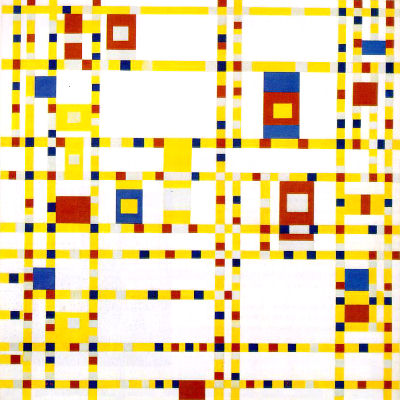Insights to Art
Mondrian's Broadway Boogie-Woogie

Piet Mondrian, Broadway Boogie-Woogie - MOMA, New York

Piet Mondrian, Broadway Boogie-Woogie (1942-43; 127cm x 127cm)
From Holland to Paris
Piet Mondrian (b. 1872, d. 1944) completed Broadway Boogie-Woogie, his last finished painting, the year before his death, and in many ways the canvas is a very eloquent conclusion to his life and his painting career. Mondrian was born and brought up in the Netherlands, where he began painting landscapes. From stark paintings of tall trees, Mondrian soon moved towards a more abstract style. The time he spent in Paris before the First World War introduced him to Cubism, which led him to a more unmitigated abstraction, a style he termed "Neo-Plasticism". Back in Holland he joined an artistic group known as De Stijl (The Style) which promoted a particularly severely modern, austere Neo-Plastic style. In the 1920s and 30s, Mondrian produced his famous geometric canvases such as Composition in Red, Yellow and Blue (1921) or Composition with Blue and Yellow (1932) with grids of intersecting black lines and coloured rectangles.

Piet Mondrian, Composition with Red, Yellow and Blue (1927)
From London to New York
With the onset of the Second World War, Mondrian left continental Europe, first for London in 1938, then settling in New York from 1940. Although in his late sixties, Mondrian fell in love with New York, and the city gave him a new view on life. Surrounded by young American artists, he was fascinated by the skyscrapers, the lifestyle of the metropolis, and even by the boogie-woogie dance craze. His New York paintings, including New York City 1, Broadway Boogie-Woogie and Victory Boogie-Woogie (unfinished on his death), also took on a new direction.
Stylistic Fundamentalism
Europe in the late 19th and early 20th centuries was in a state of philosophical and artistic upheaval. New developments in science (particularly the theory of evolution) had to be reconciled with religion, and developments in the direction of abstract art had to be supported by theoretical bases that could rebuff any accusation of aimless pattern-making. Mondrian's own theories of Neo-Plasticism tied in with the ideas of De Stijl, as well as with the principles of the Theosophy movement that had purportedly resolved the conflict between science and religion. Struggling between mysticism and Calvinism, prosaic theories and his art, Mondrian wrote a series of articles to define his artistic position. He stated that the aim of Neo-Plasticism was to seek harmony and balance; art was seen as a bridge between reality and harmony. "In the vital reality of the abstract," Mondrian stated, "the new man has outgrown the sentiments of nostalgia, joy, rapture, sadness, horror, etc." While many symbolic or religious interpretations have been put forward for his paintings, his style and theories remained balanced, dematerialised, clear and pure.
New York and Boogie-Woogie
Mondrian arrived in New York in 1940, at the age of 68. His theories and art style had been finalised almost twenty years earlier, and although he was already a devoted city-dweller, there was no hint of the explosion of artistic innovation that New York would bring to the last four years of his life. The static, balanced approach of his European art suddenly took on a whole new dynamism. Europe of the war years was harsh, bleak and discouraging. All of a sudden, Mondrian was transplanted to an exhilarating, lively, war-free environment in the midst of the boogie-woogie dance craze. He was captivated by this new world, and before long he was, as he himself termed it, "putting a little boogie-woogie" into his paintings.
From Austerity to Exuberance
Mondrian did not abandon his Neo-Plasticism; he remained true to the most basic of horizontal and vertical lines and the three primary colours. But his New York paintings omit the austere black lines, and his once thick bars of black are now broken up into jazzy, multicoloured, criss-crossing plays of lines. He dedicated his first colourful stateside painting "New York City 1" to his new home. His work took on a new lively rhythm, almost like the busy New York road network, almost like the dynamic, jittery rhythm of boogie-woogie music. The austerity of his previous paintings developed an exuberance, perhaps regaining some of that "joy" which he had previously banished from his paintings (and from his life?).

Piet Mondrian, New York City 1 (1942)
© Nigel J. Ross, 2003
Home |
Publications |
Dictionaries |
English Lang. |
Art Insights |
Travel |
Links | ||||||